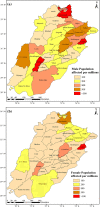Prevalence and Associated Risk Factor of COVID-19 and Impacts of Meteorological and Social Variables on Its Propagation in Punjab, Pakistan
- PMID: 34723081
- PMCID: PMC8260326
- DOI: 10.1007/s41748-021-00218-5
Prevalence and Associated Risk Factor of COVID-19 and Impacts of Meteorological and Social Variables on Its Propagation in Punjab, Pakistan
Abstract
The current study identifies the spatial distribution of COVID-19 cases and its association with meteorological and social variables in Punjab (densely populated province of Pakistan). To identify the COVID-19 propagation, the weekly growth, recovery, and deaths rate have also been calculated. The geographic information system (GIS) has used to determine COVID-19 impacts on gender (male/female), age groups, and causalities over an affected population (km-2) for the period of 11th March to 12th August, 2020 in each district of province. Our results show that 43 peak days (where daily positive cases were above 900) have been observed in Punjab during 27th May to 8th July, 2020. The high population density districts, i.e., Lahore and Islamabad, have been affected (five persons per square kilometers) due to COVID-19, whereas the maximum death tolls (> 50 persons per millions) have also been observed in these urban districts. The meteorological variables (temperature, humidity, heat index, and ultraviolet index) show negative significant relationship to basic reproduction number (R0), whereas daily COVID-19 cases are positively correlated to aerosols concentration at 95% confidence level. The government intervention (stringency index) shows a positive impact to reduce the COVID-19 cases over the province. Keeping in view the COVID-19 behavior and climatology of the region, it has been identified that the COVID-19 cases may likely to increase during the dry period (high concentration of aerosols) i.e., October-December, 2020 and post-spring season (April to June), 2021 in urban areas of Pakistan. This study provides an overview on districts vulnerability that would help the policy makers, health agencies to plan their activities to reduce the COVID-19 impacts.
Keywords: Aerosol; COVID-19; GIS; Meteorological variables; Punjab; Stringency index.
© King Abdulaziz University and Springer Nature Switzerland AG 2021.
Conflict of interest statement
Conflicts of interestThe study was based on data available in public domain; therefore, no ethical issue and conflict of interest.
Figures







References
LinkOut - more resources
Full Text Sources
Miscellaneous
